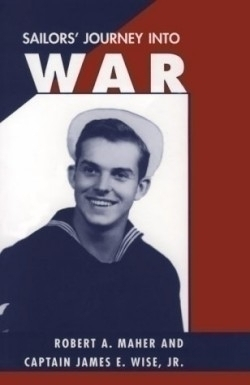Sailors' Journey into War
There’s something about American faces in 1940, so open and innocent and eager that it seems a lost era, a time before we learned the world could be ugly and cruel. Robert Maher’s face shines from the cover of Sailors’ Journey into War like a beacon, and his photographs of World War II shipmates make them look like young actors in a Broadway play—not the very efficient killers they came to be.
This memoir of the American antisubmarine campaign in the Atlantic captures a critical turning point in World War II, when small aircraft carriers and dashing destroyers finally gained the upper hand on the Nazi submarine wolfpacks that had sent hundreds of thousands of tons of ships and supplies to the ocean bottom in the early years of the war. Maher’s ship, the U.S.S. Borie, and others like it kept open the supply lines to England and to Allied forces in Europe.
The Borie escorted huge convoys of tankers and supply ships across the Atlantic, picked up survivors from torpedoed ships, and dropped depth charges on sonar pings, hoping to cripple an invisible enemy. But a change in tactics and excellent intelligence, gave the Borie and her sister ships important advantages—and Maher was soon looking right into the eyes of enemy sailors.
The heart of this story is a wild and dangerous night in late 1943 when the Borie drove a U-boat to the surface with depth charges, pinned it with a powerful searchlight, and blasted it with 4-inch guns and heavy machine gun fire. The German crew proved incredibly brave, and the sub tried every maneuver to escape. Maher, standing above the bridge with his hands on the fire control keys, heard an order rarely shouted since the days of rowed ships: “Stand by for a ram!” The Borie rode up over the top of the sub, and the two ships locked together in the dark swells of the ocean. Too close to bring the main guns to bear, the American and German crews broke out small arms and fired at each other at point blank range, desperately killing—and dying. Both ships were mortally wounded in one of the most incredible naval battles of the war.
Readers may tire of Maher’s sense of humor, and will certainly page quickly through dull filler material before and after the battles in the Atlantic, but the camaraderie of young sailors at war, their pride in their growing professionalism, and their sadness at the loss of friends will stick in the memory for a long, long time.
Disclosure: This article is not an endorsement, but a review. The publisher of this book provided free copies of the book to have their book reviewed by a professional reviewer. No fee was paid by the publisher for this review. Foreword Reviews only recommends books that we love. Foreword Magazine, Inc. is disclosing this in accordance with the Federal Trade Commission’s 16 CFR, Part 255.

